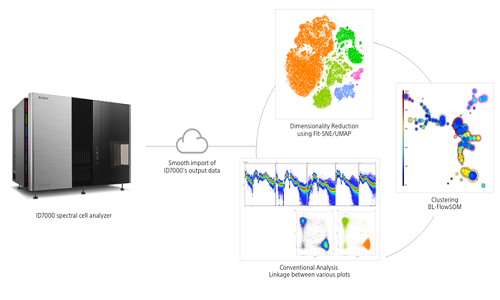Sony Announces the Launch of the SFA – Life Sciences Cloud Platform, a Cloud-based Solution for Flow Cytometry Data Analysis
Sony Corporation (“Sony”) has announced the launch of the SFA – Life Sciences Cloud Platform, a flow cytometry data analysis cloud solution that can quickly identify rare cells, such as cancer cells and stem cells, from a wide variety of cell populations, using data obtained from flow cytometers.
The SFA – Life Sciences Cloud Platform is a cloud-based solution that can efficiently perform a wide array of analysis protocols, ranging from conventional analysis including gating, in which only specific cell populations are selected for analysis and quantification based on differences in scattered light and flourescence signal intensity, to advanced analysis such as dimensionality reduction, which enables a two-dimensional view of multi-dimensional information, and clustering, which automatically classifies cell populations.
The solution is compatible with Sony’s flagship ID7000™ spectral cell analyzerii that delivers streamlined multicolor cell analysis with more than 44 colorsiii. The raw data output and analysis results from the ID7000 software can be directly imported and analyzed without any conversion. In addition, this solution features BL-FlowSOMiv, a newly developed algorithm that speeds up FlowSOM, one of the clustering methods. Furthermore, because each algorithm is pre-installed in the cloud environment, immediate analysis is possible, and results from the data analysis can be managed and shared among users.
A flow cytometer is a powerful tool that analyzes cell characteristics by irradiating laser light onto cells stained with a fluorescent reagent that emits light under specific conditions, which then detects the emitted light as scattered light and fluorescent. This analysis method is called flow cytometry and can measure the size and number of a wide variety of cells, as well as information on the cell surface and interior content (such as structure, functions and biomarkers) very rapidly—analyzing tens of thousands of cells in under one second.
Flow cytometers are used in research fields such as immunology, oncology, and regenerative medicine for basic research, elucidation of disease causes, and drug development. As research advances, there is a growing need for instruments such as the ID7000, which can comprehensively acquire various cellular information in a single process. Analysis using algorithms, such as dimensionality reduction and clustering, has also been developed to quickly process the multicolor and extensive amount of cellular information obtained from such instruments.
“The SFA – Life Sciences Cloud Platform is Sony’s first cloud service for life sciences, which was developed based on the needs of research sites and the knowledge gained from providing advanced flow cytometers such as the ID7000,” said Taisuke Kawasaki, Senior General Manager, Life Science Division, Sony Corporation. “Through our solution, the data obtained from the ID7000 can be directly imported and efficiently used in both conventional analysis with a high degree of freedom, and for advanced analysis, which enables researchers to gain deeper insights easily and quickly by analyzing a large amount of data at high speed.”
Sony will start providing the SFA – Life Sciences Cloud Platform this winter.
Main Features
Machine-learning-based advanced analysis for rapid identification of cell populations and survey of multi-dimensional informationv
Various algorithms can be used to quickly identify cell populations and survey multi-dimensional information with guaranteed objectivity. In addition, since all analysis methods are performed in the cloud, they are not limited by the processing power of the workstation and can be performed at a stable speed.
Quick survey of multicolor data through dimensionality reduction
UMAP (Uniform Manifold Approximation and Projection) and FIt-SNE (Fast Fourier transform-accelerated Interpolation-based t-SNE), which are dimensionality reduction algorithms, can be used in this solution. They convert the structure of multidimensional data to lower dimensions while retaining as much important information as possible. These algorithms make it easier to understand the characteristics of the data and allow for an overview of the multi-color data output from the ID7000.
Newly developed clustering algorithm speeds up analysis
This platform features BL-FlowSOM, a newly developed algorithm based on the flow cytometry data clustering method, FlowSOM. BL-FlowSOM realizes faster analysis and improved reproducibility of analysis results. In addition, auxiliary functions such as meta-cluster editing, which roughly groups fine clusters by cell characteristics, and heat map analysis, which shows how much antigen is expressed for both clusters and meta-clusters, are also available with BL-FlowSOM.
Ensuring objectivity by data cleaning
Various algorithms (flowAI, flowCut, flowClean, PeacoQC(Peak-based selection of high quality cytometry data)) can be used to automatically detect and remove noise in the data generated by turbulence in the pumped liquid during measurement with the flow cytometer. This can be performed prior to dimensionality reduction and clustering, leading to more objective results.
Improved linkage between various types of plots
After various analyses, all plots can be linked and manipulated on the screen, including two-dimensional plots that display cellular information as a scattergram of two parameters, a spectrum plot that shows raw fluorescence data for each wavelength range, a dimension reduction plot that allows a two-dimensional overview of multidimensional information, and a minimal spanning tree (MST) plot that shows data after clustering. This enables more efficient analysis; for example, the two-dimensional plot can be contrasted with the dimensionality-reduced plot for each cell, which was not possible in the past.
Pursuing ease of use for researchers
Conventional analysis can also be used
When analyzing histograms and two-dimensional plots, the same basic analysis functions as the ID7000 Software can be performed in the cloud, including scaling to set the range and logarithmic display of specific axes, as well as gating. These analyses can be combined with advanced analysis to support deeper insights.
Seamless import of ID7000’s output data
The system raw data files output from the ID7000 can be directly imported and analyzed using the SFA – Life Sciences Cloud Platform functionalities. When using advanced analysis, there is no need to convert the data to other file formats, and the analyzed worksheet information can be introduced directly. In addition, the spectral data including the intensity information of each fluorescence signal before the conversion can also be transferred from ID7000, allowing researchers to return to the raw data and review their analysis.
Multiple algorithms can be used without pre-configuration
Algorithms such as UMAP, FIt-SNE, and BL-FlowSOM are pre-installed in the cloud, so there is no need to add them as plug-ins. Users of various proficiency levels can immediately use multiple algorithms.
Easy data management and sharing
Data obtained from the ID7000 and data generated after various analyses can be stored in the cloud, making it easy to manage the data itself and share data between workstations with users who are conducting collaborative research. Each licensed user has access to a collaborative analysis location for experimental data that can be configured for sharing on a project need basis, and each licensed user can choose and manage access to this content. The ability to share experimental data makes it easy for users to collaborate and promotes scientific discovery.
Source: Sony Corporation


